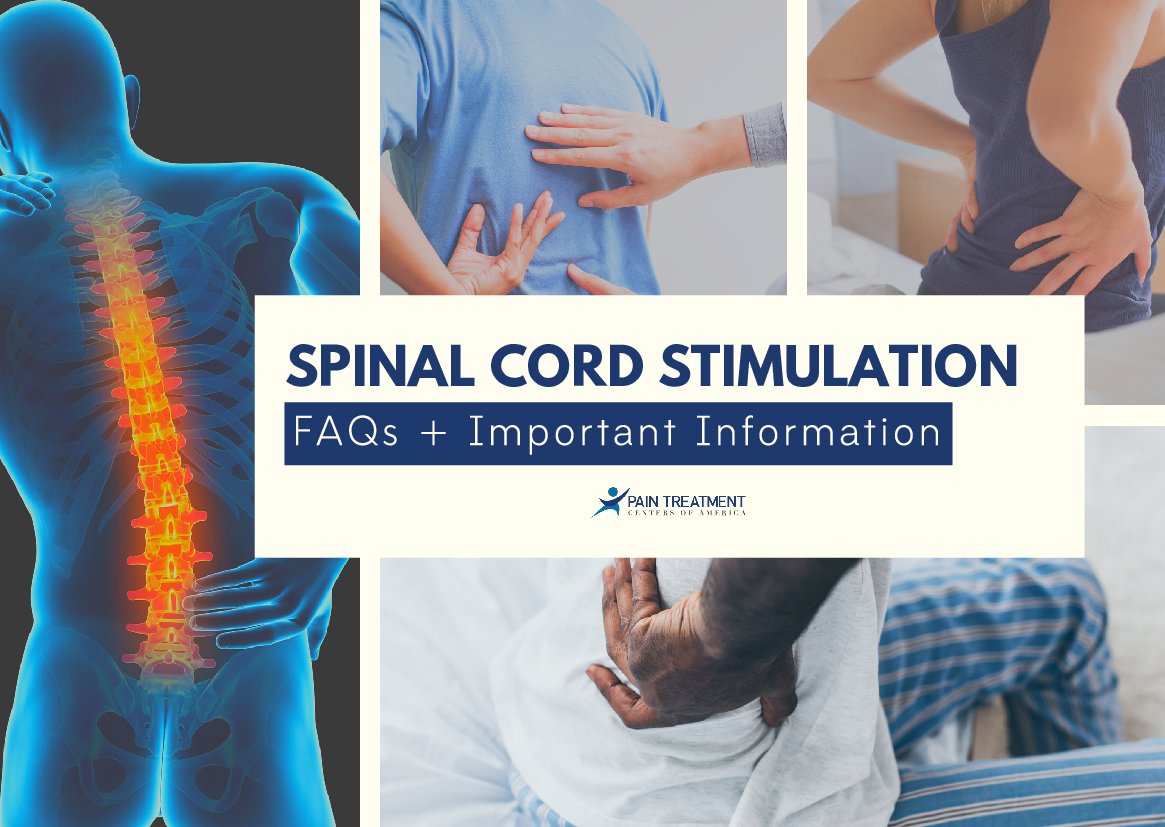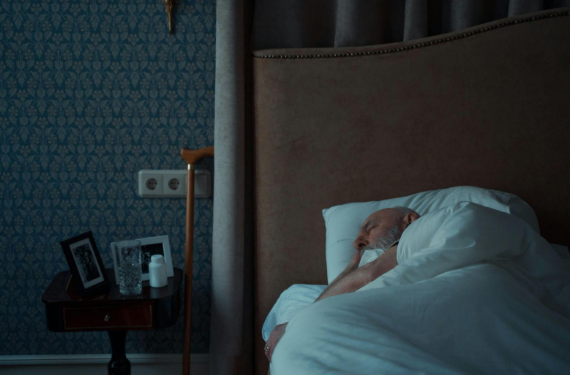Spinal Cord Stimulator FAQs + Info

Chronic back pain--pain that lasts for 12 weeks or more--is one of the leading causes of disability and lost time at work in the United States. Back pain, either acute or chronic, was the second most common patient-reported medical complaint in one study that covered 12 countries and five continents1. Chronic low back pain has even been linked to a lower perceived quality of life in affected patients2.
Diagnosis and treatment of back pain is complex and sometimes difficult. Back pain can be caused by a number of conditions and injuries and can plague individuals long after an injury has healed or a condition has been treated.
For patients experiencing chronic back pain that hasn’t responded to traditional treatment options, like anti-inflammatory drugs, physical therapy or rest, a spinal cord stimulator trial may be an effective solution.
Here’s what you should know about this life-changing pain treatment option
What is Spinal Cord Stimulation?
Spinal Cord Stimulation (SCS) is a minimally-invasive procedure that implants a neuromodulation device (pulse generator) in the spine of a person experiencing chronic back pain. The device is controlled by the patient, who uses a remote control to trigger the release of tiny electrical pulses when he or she experiences back pain.
These electrical signals stimulate the nerves in the spine, interrupting the pain signals those nerves are sending to the brain.
Spinal cord stimulation has been used for over 40 years in treating chronic back pain.
Which Pain Conditions Can Be Treated With a Spinal Cord Stimulator?
A number of conditions cause pain that is non-responsive to traditional pain treatments. In these cases, spinal cord stimulation may provide an exceptional level of pain relief and may allow patients to reduce the amount of pain medication they need to manage their symptoms.
The conditions have been successfully treated with spinal cord stimulators:
Failed Back Surgery Syndrome.
FBSS is not actually a syndrome. Instead, it’s
a collection of symptoms experienced by individuals who have undergone back surgery that wasn’t successful3. Failed Back Surgery Syndrome causes persistent, new or worsening pain following back surgery. This pain often results from the buildup of scar tissue around spinal nerves, recurrent disc herniation, and errors by surgeons. Pain caused by FBSS may not respond to traditional pain treatments.
Neuropathy. Neuropathy is a painful condition caused by damage to nerve tissues. When a nerve is damaged, it can produce an abnormal pain sensation, even when there is no painful stimuli4. Neuropathy symptoms include numbness, muscle weakness, tingling, a feeling of pins and needles, and general pain in the affected areas. Neuropathy commonly occurs in people with diabetes or HIV or in those who are undergoing chemotherapy treatment. It is also found in people who drink heavily or those working in professions that require repeated physical movements.
Complex Regional Pain Syndrome. CRPS, also known as reflex sympathetic dystrophy syndrome, is a condition that causes chronic pain as a result of dysfunction or inflammation in the peripheral or central nervous systems5. This nerve system dysfunction is typically caused by an injury, prior surgery, and prolonged lack of movement in a limb. Rarely, CRPS can occur without a clear cause. CRPS can cause a variety of pain sensations, including burning, throbbing, temperature sensitivity, swelling and muscle spasms. It can also cause changes in skin texture and color, abnormal hair and nail growth, and muscle weakness in the affected area.
Arachnoiditis.
Arachnoiditis is a rare pain condition caused by inflammation in one of the spinal nerves’ protective membranes. Arachnoiditis can be caused by a number of conditions or incidents, including injury, infection, exposure to chemicals, failed spinal surgery, and compression of the spinal nerves. The condition causes shooting pains, numbness, tingling, and even a sensation of insects crawling on the skin. Some individuals with arachnoiditis experience muscle cramps, involuntary muscle twitching, and bladder, bowel and sexual problems.
Outside of these conditions, a spinal cord stimulator may work for individuals who stump pain, multiple sclerosis and other conditions.
It is important to talk to a pain specialist about the nature, severity, and duration of your pain. If you’ve been experiencing chronic back pain for a long time, a pain specialist may be able to help.
What is a Spinal Cord Stimulator Trial?
Before a patient can receive a spinal cord stimulator implant--a permanent implant in the spinal canal--he or she must undergo a spinal cord stimulator trial. The trial phase is extremely important, as it will allow your pain management provider to determine how effective spinal cord stimulation is in relieving your pain.
During the trial phase, the epidural space--the outermost area of the spinal canal--is accessed using x-ray guidance and an epidural needle. Once proper placement of the needle has been confirmed, your pain specialist will insert a small electrode through the needle and confirm proper placement in the epidural space. These electrodes are connected to a spinal cord stimulator device that, when activated, sends tiny electrical pulses to the epidural space. After one electrode is successfully placed, the process is repeated to place a second electrode. Placement of two electrodes is typical during the trial phase.
After proper placement of the electrodes, a member of the device’s team will activate the spinal cord stimulator and ask you to describe the sensations you experience as he or she adjusts the device’s settings. A successful trial will gradually replace pain sensations with a pleasant tingling feeling, a process which typically takes only 10 minutes.
After the initial test of the electrodes, your pain specialist will remove the epidural needle and secure the electrodes to your back with tape and a small number of stitches. Once this is complete, you will leave the clinic and begin a 5-day trial of the device. During the trial, you should continue all daily activities normally. You should also continue to take any prescribed daily pain medications. During this time, pay close attention to your pain levels and how your activity level is affected due to your pain.
At the end of the five day trial period, you will return to the pain clinic to have the electrodes removed. You will also talk to your doctor about the effectiveness of the trial in reducing your daily pain.
If you experienced at least a fifty percent reduction in pain and were able to complete daily activities more easily, you’re likely a good candidate for a spinal cord stimulator implant.
Permanent Implantation of a Spinal Cord Stimulator After Successful Trial
If a patient has undergone a successful spinal cord stimulator trial, he or she may elect to receive a permanent implanted device.
Permanent implantation of a spinal cord stimulator is a surgical procedure that is performed under general anesthesia in an operating room.
The permanent implantation can be done via laminotomy, performed by an outside surgeon, or via percutaneous implant, performed by a pain specialist.
It’s important to talk with your pain specialist about the risks, benefits and potential complications of permanent implantation via laminotomy versus percutaneous implantation.
What Are the Potential Complications of a Spinal Cord Stimulator?
Spinal cord stimulation is considered a safe procedure.
However, there are risks associated with any surgical procedure, including:
- Infection at implant site
- Device migration (a permanent device is typically implanted using sutures to minimize post-procedure migration)
- Damage to the device, typically caused by an injury, intense physical activity like heavy lifting, or physical trauma near the implant site
- Dural damage, leading to severe headaches
- Nerve damage and paralysis
It’s important to note that serious biological complications, like dural damage, nerve damage or spinal trauma, are extremely rare6.
Spinal Cord Stimulator Trials and Implantation with PTCOA in Arkansas
Many people with chronic back pain suffer for years without ever truly learning which options are available to address their pain.
The pain management specialists at Pain Treatment Centers of America specialize in the diagnosis and treatment of chronic back pain, including pain that doesn’t respond to traditional treatments.
If you’re suffering from chronic back pain, our pain specialists may be able to recommend new treatments or procedures that finally provide you with relief.
If you’re interested in learning more about spinal cord stimulation at Pain Treatment Centers of America, contact us today:
(844) 215-0731.
Sources:
- "What are the most common conditions in primary care? - NCBI." https://www.ncbi.nlm.nih.gov/pmc/articles/PMC6234945/.
- "Personal and Societal Impact of Low Back Pain - LWW Journals." 15 Dec. 2019, https://journals.lww.com/spinejournal/fulltext/2019/12150/personal_and_societal_impact_of_low_back_pain__the.9.aspx
- "Failed back surgery syndrome: current perspectives - NCBI." 7 Nov. 2016, https://www.ncbi.nlm.nih.gov/pmc/articles/PMC5106227/.
- "Peripheral Neuropathy Fact Sheet | National Institute of ...." https://www.ninds.nih.gov/Disorders/Patient-Caregiver-Education/Fact-Sheets/Peripheral-Neuropathy-Fact-Sheet.
- "Complex Regional Pain Syndrome Fact Sheet | National ...." https://www.ninds.nih.gov/Disorders/Patient-Caregiver-Education/Fact-Sheets/Complex-Regional-Pain-Syndrome-Fact-Sheet.
- "Chiropractic management of post spinal cord stimulator spine ...." 6 Feb. 2017, https://www.ncbi.nlm.nih.gov/pmc/articles/PMC5292803/.













